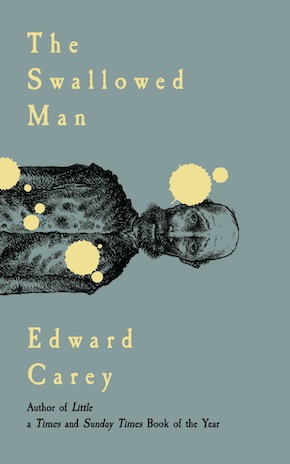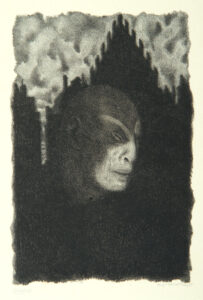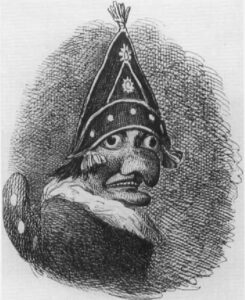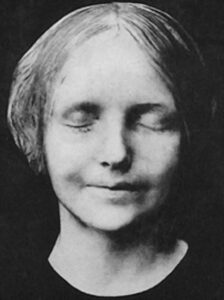Mannequins and monsters
by Edward Carey
“Profound and delightful… a strange and tender parable of two maddening obsessions; parenting and art-making.” Max Porter
Edward Carey’s The Swallowed Man follows the adventures of Pinocchio’s creator Geppetto after he is stranded in the belly of a sea beast. As the woodcarver ekes out a frugal existence, living on his memories and imagination, the tale becomes a magical meditation on fatherly love, loss and regret, and the transformative power of creative art. The author considers his all-time favourite portrayals of artificial humans.
Pinocchio
Carlo Collodi’s book The Adventures of Pinocchio reveals a much more lively, naughty, and outrageous child than Disney’s dull innocent. He’s so wonderfully strange, this thing of wood, this object that so longs to be a human. In the book he burns his own feet off, and is hanged from a tree by the cat and the fox. It’s a much darker, more mysterious, more joyful, more harrowing story than the cartoon film would have you believe. The wooden puppet is so full of life, he can’t be contained or kept still. At the end of the book, when Pinocchio is at last turned into a flesh child, the wooden puppet – though lifeless – is still present. In an act of astonishing betrayal the book closes with the flesh child laughing at his former self. A brilliantly haunting tale.
Frankenstein’s monster
“Beware; for I am fearless, and therefor powerful!” Mary Shelley’s immortal creation is, like the wooden child, so well known and exists in very many versions. Is there any more lonely and haunted figure in all fiction? The monster, Adam, is amongst us but is not one of us, this cruel puzzle of human pieces is both terrifying and heartbreaking.
The Golem of Prague

Illustration by Hugo Steiner from Gustav Myrink’s Der Golem, 1916. Center for Jewish History, New York/Wikimedia Commons
Created by Rabbi Loew to defend the Prague ghetto in the sixteenth century, this artificial man was made of clay from the banks of the Vlatava River. But one Friday evening the rabbi forgot to remove the shem – God’s name written on a piece of paper and placed inside the Golem’s mouth – and the creature became violent. In the end the rabbi managed to pull the shem free in front of the Old-New Synagogue and the creature shattered. Afterwards it is said the fragments were kept in an attic in the synagogue. Some versions of the story have the Golem falling in love. Gustav Myrink wrote a wonderful novel about the creature, and it is hard not to think the story had a great influence on Franz Kafka – particularly, perhaps, his story The Cares of a Family Man and the odd and rather humble assemblage that calls itself Odradek.
R.U.R. (Rossum’s Universal Robots) by Karel Čapek
Čapek, too, was from Prague and his 1921 play – marking the first ever use of the word ‘Robot’ – concerns a factory for artificial humans. These fake humans seem like us and at first exist with ease alongside us but soon they rebel and put an end to the human race. Interestingly, they are made not of metallic parts but rather of artificial flesh.
Mr Punch
We know he’s not real, and yet he does terrify so. This puppet, with a human hand operating him, is such an extraordinarily vivid character. Instantly recognisable, violent, cruel, laughing and with a voice that is purely his own, Punch’s hideous energy is so strange and exciting. I especially love Cruickshanks’s drawings of him. What a cruel, unattractive, energetic little scrap of nastiness he is, it seems rather odd that he is a seaside attraction.
Olimpia the automaton from The Sandman by E.T.A. Hoffmann
In Hoffman’s extraordinary tale, the student Nathaniel, already deeply disturbed by a strange figure from his childhood, finds himself falling in love with an inventor’s daughter called Olimpia. He speaks to her, he dances with her, but he alone it seems cannot understand that she is not real. When he does discover that the woman he loves is artificial, and the doll is broken, the result is deeply traumatising and leads to Nathaniel’s eventual death.
L’Inconnue de la Seine
In the late 1880s a young woman’s body was pulled out of the Seine, no one knew who she was and how she had come to be there. A cast was made of her beautiful and haunting face and hundreds of copies were made from it. This heartbreakingly sweet face became the model for medical resuscitation practice dummies, “the most kissed face of all time.”
The Mennyms, in the novels of Sylvia Waugh
This family of life-size rag dolls exists very privately in a house in England. Their maker has died but they are alive and keep themselves aloof from humanity – though they contrive various ways to keep their existence possible. They are terrified of being discovered, and the novel begins with a letter from Australia and a relative of their maker’s promise to visit. Strange, funny and oddly beautiful.
The wax dolls of Lotte Pritzel
Rainer Maria Rilke describes these unattractive objects in an extraordinary essay as dolls that have no children in their lives. He wonders what happens to the formerly beloved childhood toys after they have been abandoned, with no love or tenderness in their lives. Thin, lonely, worn-out, resentful. The essay explores with great eloquence the relationship between a child and her precious objects.
Guy Fawkes
Our disturbing annual holiday, which might be called Burn a Catholic Night, was always one of the most mysterious and wild nights of my childhood. I could never stop feeling some sympathy for the poor objects we’d put together only to destroy them on the top of a bonfire. It wasn’t until much later that I discovered that Fawkes threw himself from the executioner’s scaffold and broke his neck; when Fawkes was executed he was already dead.

Edward Carey is a novelist, visual artist and playwright. His novel Little (Gallic Books, 2018), about the creation and creations of Madame Tussaud, was longlisted for three major literary prizes and has been published in 20 countries. He is also the author of Observatory Mansions, Alva and Irva: the Twins Who Saved a City, and the YA Iremonger Trilogy. Born in North Walsham, Norfolk, he teaches at the University of Texas at Austin. The Swallowed Man, illustrated by the author, is published in hardback, trade paperback and eBook by Gallic Books.
Read more
edwardcareyauthor.com
@EdwardCarey70
@BelgraviaB



